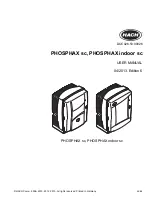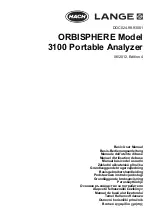
English – 11
nano
TM
Operating Instructions
WARNING
Always wear eye protection to protect your eyes
against dirt and other foreign objects.
When inspecting drains that might contain hazard-
ous chemicals or bacteria, wear appropriate pro-
tective equipment, such as latex gloves, goggles,
face shields, and respirators to prevent burns and
infections.
Do not operate this equipment if operator or ma-
chine is standing in water. Operating the machine
while in water increases the risk of electrical
shock. Rubber soled, non-slip shoes can help pre-
vent slipping and electric shock, especially on wet
surfaces.
Perform the following to reduce the risk of injury
from electrical shock and other causes:
1. Make sure all equipment is properly set up.
2. Pull several feet of push cable from the nanoReel.
Make sure the camera window is clean. In some
cases, placing a slight film of detergent on the
window can minimize debris sticking to the window.
Place the camera unit into the line to be inspected.
3. Turn the CCU ON. Adjust the camera head LED
lighting brightness and the display image as
specified by the CCU operator’s manual. Make
adjustments to the brightness as necessary.
For instance, white PVC pipe requires less light
than black PVC. Slight adjustments in lighting
brightness can highlight issues discovered during
an inspection. Always use the least amount of
lighting to maximize picture quality and reduce
heat buildup.
4. To record the inspection, follow the instructions in
the specific CCU operator’s manual.
5. If possible, run water through the system during the
inspection to help keep the system clean, to make
pushing the push cable easier, and to help orient
the image at the bottom of the pipe. This can be
done by placing a hose down the line or turning
on a fixture (for example: flushing a toilet). Shut off
water flow as needed for viewing.
6. Grip the push cable and carefully feed it into the
drain to be inspected. Use rubber gripper type
gloves to manipulate the push cable to improve
grip and to help keep hands clean.
NOTICE
Use of the nanoReel camera in porcelain ap-
pliances scratch the surface finish of the porcelain. To
avoid scratching, use a curved non-marking pipe segment
(such as PVC or ABS pipe) to lead the camera past the por-
celain bowl and into the drain. See the “Using Guide Tubes”
section in this Operator’s Manual for more information.
Figure 14 – Performing an Inspection
When pushing the push cable in to the line, keep the
push cable clear of any sharp edges on the inlet that
could cut, grab, or damage the push cable. Grasp and
push short sections of push cable at a time and keep
your hands near the inlet to better control the push cable
and to prevent it from folding over, snapping, cutting or
otherwise damaging the push cable jacket. Cutting the
push cable jacket could increase the risk of electrical
shock.
When feeding the push cable into the line, watch the
monitor to see what is coming. When the lights are set at
less than maximum setting, it may help to occasionally
turn the brightness up to see what is coming further
down the line.
Be aware of obstructions (such as crushed pipe) or
excessive hard build up in the line that could prevent
retrieval of the camera. Do not try to use the camera
head to clear obstructions. The nanoReel is a diagnostic
tool, not a drain cleaner. Using the camera head to clear
obstructions could damage the camera head or cause it
to be caught in the obstruction, preventing removal.
www.calcert.com
1.800.544.2843
0
5
10
15
20
25
30


































